
Java Collection的使用
Collection 方法介绍
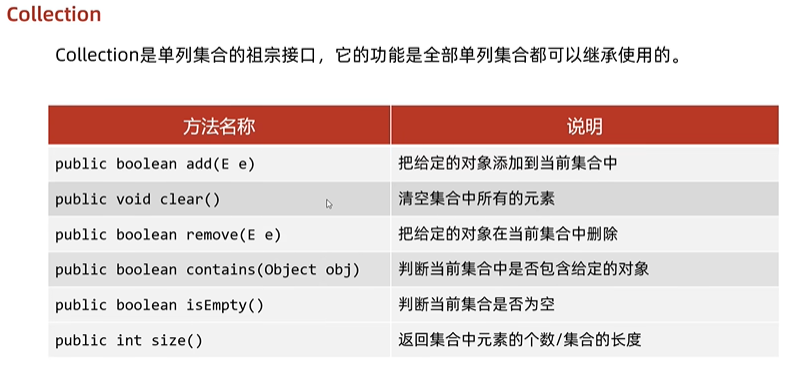
Collection 使用
注意:Collection 是一个接口不能直接创建对象,下面使用实现类的对象ArrayList来测试
创建Collection对象
public static void main(String[] args){
Collection<String> collection = new ArrayList<>();
}
add方法
public static void main(String[] args){
Collection<String> collection = new ArrayList<>();
collection.add("dog");
collection.add("cat");
collection.add("age");
// 打印集合
System.out.println(collection);
}

注意:在使用add方法会返回bool类型数据-在List系列类型中返回值永远都是true
在Set中,如果当前要添加的数据已经存在返回false
因为Set集合元素不可重复,List可重复-所以在添加的时候Set中有这个元素就代表添加失败。
clear方法
public static void main(String[] args){
Collection<String> collection = new ArrayList<>();
collection.add("dog");
collection.add("cat");
collection.add("age");
collection.clear();
// 打印集合
System.out.println(collection);
}

remove方法
public static void main(String[] args){
Collection<String> collection = new ArrayList<>();
collection.add("dog");
collection.add("cat");
collection.add("age");
collection.remove("age");
// 打印集合
System.out.println(collection);
}

在remove方法中,如果删除成功返回true,删除失败返回false
contains方法
public static void main(String[] args){
Collection<String> collection = new ArrayList<>();
collection.add("dog");
collection.add("cat");
collection.add("age");
collection.remove("age");
System.out.println(collection.contains("cat"));
System.out.println(collection.contains("age"));
// 打印集合
System.out.println(collection);
}

注意:在contains方法底层实现是依赖于equals方法的,如果在集合中保存的是自定义类的数据,那么一定要重写equals方法。
isEmpty方法
public static void main(String[] args){
Collection<String> collection = new ArrayList<>();
collection.add("dog");
collection.add("cat");
collection.add("age");
System.out.println(collection.isEmpty());
collection.clear();
System.out.println(collection.isEmpty());
}

可以直接使用 collection.size() == 0 来代替方法(ArrayList底层就是这样实现的)
size方法
public static void main(String[] args){
Collection<String> collection = new ArrayList<>();
collection.add("dog");
collection.add("cat");
collection.add("age");
System.out.println(collection.size());
}

Collection 的遍历
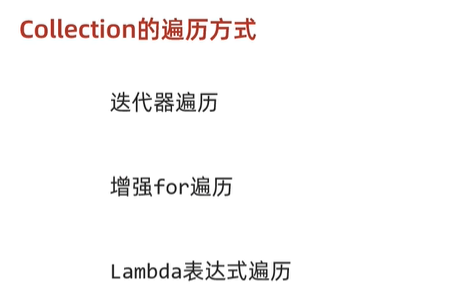
迭代器遍历
底层实现就是用到了:数据结构中的链表实现
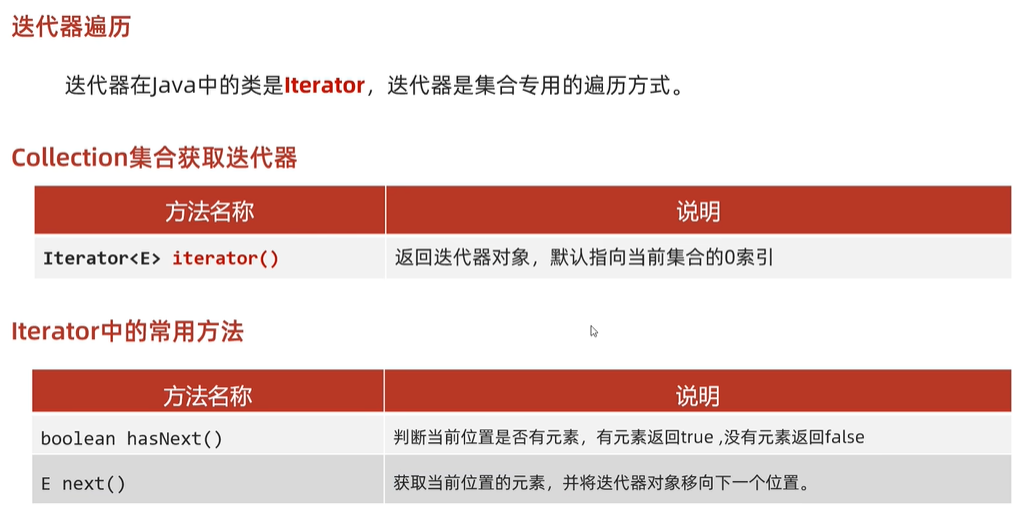
public static void main(String[] args){
Collection<String> collection = new ArrayList<>();
collection.add("dog");
collection.add("cat");
collection.add("age");
// 获取迭代器的对象
Iterator<String> iterator = collection.iterator();
// 判断当前指针指向位置是否有元素
while(iterator.hasNext()){
// 获取当前位置的元素,并将指针移动到下一个元素的位置
String data = iterator.next();
System.out.println(data);
}
}

总结:
注意:当指针已经移动到最后一个位置,然后在次调用next,此时指定指向的位置没有数据,在调用next就会报错:NoSuchElementException。
public static void main(String[] args){
Collection<String> collection = new ArrayList<>();
collection.add("dog");
collection.add("cat");
collection.add("age");
Iterator<String> iterator = collection.iterator();
while(iterator.hasNext()){
String data = iterator.next();
System.out.println(data);
}
String data = iterator.next();
}

在迭代元素的时候不能使用 collection 的remove方法,否则报错,只能在iterator使用前或者使用完毕后才可以使用。
public static void main(String[] args){
Collection<String> collection = new ArrayList<>();
collection.add("dog");
collection.add("cat");
collection.add("age");
Iterator<String> iterator = collection.iterator();
while(iterator.hasNext()){
String data = iterator.next();
collection.remove("dog");
System.out.println(data);
}
}

但是也可以使用iterator的remove()方法。进行元素删除。
public static void main(String[] args){
Collection<String> collection = new ArrayList<>();
collection.add("dog");
collection.add("cat");
collection.add("age");
Iterator<String> iterator = collection.iterator();
while(iterator.hasNext()){
String data = iterator.next();
if(data.equals("cat")){
iterator.remove();
}
}
System.out.println(collection);
}

当迭代器遍历完毕,指定不会复位,相当于遍历的iterator对象是一次性的。
迭代器遍历时,不能使用集合的方法进行添加或者删除元素。
增强for遍历
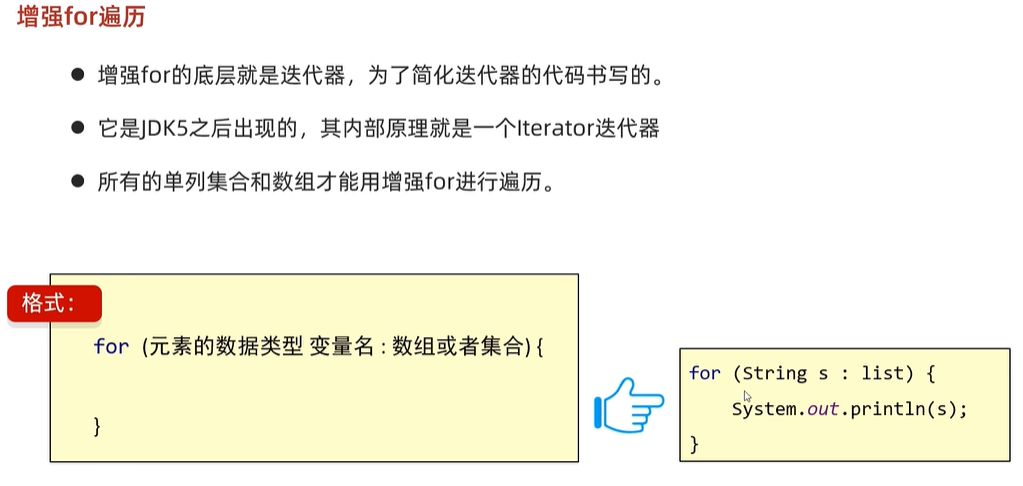
使用案例测试:
public static void main(String[] args){
Collection<String> collection = new ArrayList<>();
collection.add("dog");
collection.add("cat");
collection.add("age");
for (String s : collection) {
System.out.println(s);
}
}

弊端:运行同时不可以修改每次迭代的对象值。
public static void main(String[] args){
Collection<String> collection = new ArrayList<>();
collection.add("dog");
collection.add("cat");
collection.add("age");
for (String s : collection) {
s = "11";
}
System.out.println(collection);
}

可以将每次迭代的 s 当做一个方法的参数,当传入的是一个字符串无法修改原对象的指向地址,但是入股原对象是一个应用类型对象,传过去的地址值,就可以被修改(但是修改的是对象的内容,而还是不能修改对象本身的指向)
public class Student {
public String name;
public int age;
public Student(String name, int age) {
this.name = name;
this.age = age;
}
@Override
public String toString() {
return "Student{" +
"name='" + name + '\'' +
", age=" + age +
'}';
}
}
public static void main(String[] args){
Collection<Student> collection = new ArrayList<>();
collection.add(new Student("dog", 2));
collection.add(new Student("cat", 1));
collection.add(new Student("age", 4));
for (Student student : collection) {
student = new Student("aa", 10);
}
System.out.println(collection);
}

这边可以看到实际的数据没有被修改
public static void main(String[] args){
Collection<Student> collection = new ArrayList<>();
collection.add(new Student("dog", 2));
collection.add(new Student("cat", 1));
collection.add(new Student("age", 4));
for (Student student : collection) {
student.name = "aa";
student.age = 10;
}
System.out.println(collection);
}

修改代码,完成修改
Lambda表达式遍历

注意:jdk8之后的特性,所以需要jdk8或以上版本才可以使用。
①、先试用匿名内部内的方式进行实现
public static void main(String[] args){
Collection<Student> collection = new ArrayList<>();
collection.add(new Student("dog", 2));
collection.add(new Student("cat", 1));
collection.add(new Student("age", 4));
collection.forEach(new Consumer<Student>() {
@Override
// 一次表示集合中的每一个数据
public void accept(Student student) {
System.out.println(student);
}
});
}

成功遍历迭代到了对象。
源码实现方式:
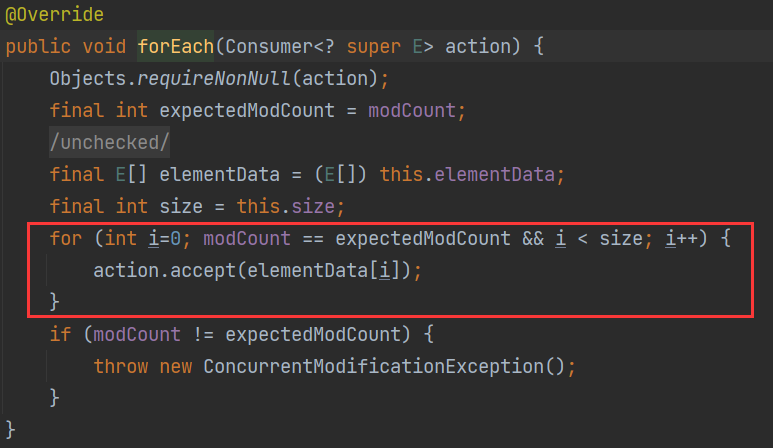
原理还是通过for循环的方式进行迭代,将每一个循环出来的元素交给accept方法进行迭代,
指的就是我们实现匿名内部内的 accept 方法。
②、lambda表达式实现
public static void main(String[] args){
Collection<Student> collection = new ArrayList<>();
collection.add(new Student("dog", 2));
collection.add(new Student("cat", 1));
collection.add(new Student("age", 4));
collection.forEach((Student sutdent) -> {
System.out.println(sutdent);
});
}
简化写法--局限于处理代码就一行的情况
public static void main(String[] args){
Collection<Student> collection = new ArrayList<>();
collection.add(new Student("dog", 2));
collection.add(new Student("cat", 1));
collection.add(new Student("age", 4));
collection.forEach(sutdent -> System.out.println(sutdent));
}

单独的输出写法扩展:
public static void main(String[] args){
Collection<Student> collection = new ArrayList<>();
collection.add(new Student("dog", 2));
collection.add(new Student("cat", 1));
collection.add(new Student("age", 4));
collection.forEach(System.out::println);
}

总结
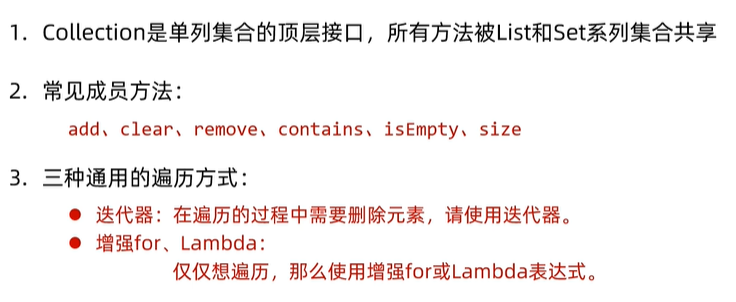




评论
登录后才可以进行评论哦!